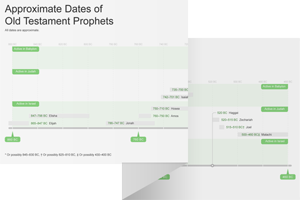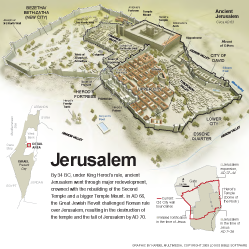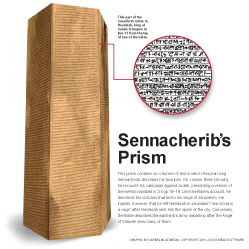1:1 Micah ministered to Jerusalem in the 8th century bc, making him a contemporary of Isaiah. |
The word of Yahweh A common introductory formula. See Hos 1:1 and note.
 Prophetic Commissioning and the Divine Presence
Prophetic Commissioning and the Divine Presence
Micah One of the few writing prophets to be mentioned by name in another prophetic book (see Jer 26:18; compare Jeremiah in Dan 9:2).
Micah means “Who is like Yahweh?” and is a shortened form of the name Micaiah (see 1 Kgs 22:8). Micah’s hometown is mentioned in Micah 1:1 to identify him since the name Micah was fairly common (e.g., Judg 17:1; 1 Chr 8:34; 2 Chr 34:20). The identification of the prophet’s hometown also indicates that his ministry probably took place in another city, likely Jerusalem. The city and its temple are emphasized throughout the book (e.g., Micah 1:2, 5; 3:12–4:2; 7:11). |
Morashtite Micah’s hometown, Moresheth, was near the Philistine city of Gath (see v. 10 and note, v. 14). Its residents were called Morashtites.
Moresheth was located approximately 25 miles southwest of Jerusalem and 20 miles east of the Mediterranean coast. The city was situated about 1,000 feet above sea level in the Shephelah near the coastal plain. It was close to the Philistine city of Gath, hence the designation Moresheth-Gath |
the days of Jotham, Ahaz, and Hezekiah Jotham reigned from 742–735 bc. Ahaz reigned from 715–697 bc. Hezekiah reigned from 729–686 bc. Since Micah does not mention Uzziah,
reigned from 715–697 bc. Hezekiah reigned from 729–686 bc. Since Micah does not mention Uzziah, it can be assumed the king died prior to the beginning of the prophet’s ministry. Since Uzziah died in 740 bc, Micah’s ministry began between 740 and 733 bc. The prophet ministered until at least the Assyrian invasion of Judah in 701 bc because he records the distress that accompanied that invasion (vv. 10–16; 5:6).
it can be assumed the king died prior to the beginning of the prophet’s ministry. Since Uzziah died in 740 bc, Micah’s ministry began between 740 and 733 bc. The prophet ministered until at least the Assyrian invasion of Judah in 701 bc because he records the distress that accompanied that invasion (vv. 10–16; 5:6).
the kings of Judah Judah was the southern kingdom of Israel.
Samaria and Jerusalem The capitals of Israel and Judah, respectively.
Samaria |
Jerusalem |
1:2 Hear The Hebrew word used here distinguishes the three major divisions of the book (see Micah 3:1; 6:1). It also reveals that what follows is an oracle.
all you peoples Micah’s prophetic oracle is addressed to the entire earth.
holy temple Yahweh’s heavenly abode, as opposed to the temple in Jerusalem. The Hebrew phrase used here appears elsewhere only in the Psalms (Pss 5:7; 11:4; 65:4; 79:1; 138:2), Jonah (Jonah 2:4, 7), and Habakkuk (Hab 2:20).
1:3 his place His heavenly temple See Micah 1:2.
tread This term is used in the sense of trampling or stomping rather than merely walking.
the high places of the earth Likely refers to both the mountains and the cultic high places, the idolatrous centers of pagan worship. See note on Isa 57:7. Treading upon them indicates Yahweh’s sovereign omnipotence (see Amos 4:13).
1:4 The mountains will melt under him The whole topography of the earth will change when Yahweh descends from heaven.
1:5 the rebellion of Jacob Jacob is used as a synonym for the people of Israel. Israel’s original name was Jacob (see Gen 32:28).
All this Refers to the coming of Yahweh in judgment as described in Micah 1:3–4.
1:6 I will make Samaria as a heap of rubble in Yahweh’s judgment on Samaria was fulfilled in 722 bc when the city was destroyed by the Assyrians.
a place for planting a vineyard The slopes of Samaria were ideal for planting vineyards.
I will pour down her stones into the valley Samaria was surrounded by valleys since it stood on the top of a large hill.
her stones Refers to the stones used to erect buildings and walls throughout the city.
1:7 idols These were commonly carved out of wood or stone.
her idols Images or statues of a deity. These idols were worshiped as the visible manifestation of the god. Yahweh strongly condemned this practice in the Ten Commandments (see Exod 20:4).
were worshiped as the visible manifestation of the god. Yahweh strongly condemned this practice in the Ten Commandments (see Exod 20:4).
the wage of a prostitute The idols of Israel are compared to the wages of a harlot. They had been made from the metal given to the temple by worshipers. Israel had accumulated wealth by engaging in idolatry, an act God regarded as adultery. These same wages will return pay a harlot—the enemy soldiers who plunder the city will spend their loot on prostitutes.
1:8 the jackals Known for their loud, mournful wails.
1:9 It has reached to the gate of my people When the Assyrian king Sennacherib invaded Jerusalem in 701 bc, he surrounded the city of Jerusalem.
1:10 Do not tell it in Gath A play on words. The name “Gath” sounds like the word for “tell.”
Gath One of the most prominent cities in Philistia.
A Philistine city located in the low hill country west of Jerusalem, near the border of Judah. It was one of the so-called Philistine Pentapolis city-states along with Ashdod, Ashkelon, Ekron, and Gaza (see 1 Sam 6:17). Gath |
you must not weep at all The nation was commanded not to weep because their mourning would bring joy to the Philistines.
Beth-le-Aphrah This name means “house of dust.” Situated between Lachish and Jerusalem, this place can be identified with modern et-Taiyibeh.
roll yourself in dust Rolling in the dust was a form of mourning designed to identify oneself with the dead.
1:11 Shaphir Means “beautiful.” Shaphir was probably located in the Philistine plain.
The inhabitants of Zaanan Means “place of flocks.” An unidentified city located in the Judaean hill country. It is probably modern-day Zenan (Josh 15:37).
the wailing of Beth-ha-Ezel Means “house of the leader.” Located in southern Judah, Beth-ezel is probably modern day Deir el-Asal.
1:12 the inhabitants of Maroth Meaning “bitterness.” An unidentified city located in the lowlands of Judah. It is probably identified with Maarath (Josh 15:59).
1:13 Harness the chariot to the team of horses Lachish was famous for its horse stables.
team of horses The term here rhymes with Lachish.
Lachish Means “impregnable.” Lachish was located about 30 miles southwest of Jerusalem and 15 miles west of Hebron. The city is identified with the modern Tell ed-Duweir.
was located about 30 miles southwest of Jerusalem and 15 miles west of Hebron. The city is identified with the modern Tell ed-Duweir.
the daughter of Zion A title routinely used for Jerusalem in the ot (see 2 Kgs 19:21; Isa 10:32; Lam 2:13; Zeph 3:14; Zech 9:9). The term Zion is frequently used for the whole of Jerusalem. See note on Isa 1:8.
is frequently used for the whole of Jerusalem. See note on Isa 1:8.
1:14 the houses of Achzib Means “deceptive.” It was located in the lowlands of western Judah. It is identified with Chezib (Gen 38:5; also rendered “Kezib”).
1:15 conqueror Refers to the Assyrian king Sennacherib (see note on Micah 1:9).
Mareshah Means “possession.” Mareshah was located in the Shephelah of Judah. It is identified with the modern Tell Sandahannah.
was located in the Shephelah of Judah. It is identified with the modern Tell Sandahannah.
Adullam Means “sealed off place.” Adullam was located about five miles south of Beth Shemesh in the hill country of Judah. It is identified with the modern Tell esh-Sheikh Madhkur. David fled to the cave of Adullam after leaving Gath (1 Sam 22:1). The leaders of the nation will now flee there from the Assyrian invasion.
1:16 cut off your hair Removing hair was a sign of mourning (see Ezra 9:3; Jer 7:29).

|
About Faithlife Study BibleFaithlife Study Bible (FSB) is your guide to the ancient world of the Old and New Testaments, with study notes and articles that draw from a wide range of academic research. FSB helps you learn how to think about interpretation methods and issues so that you can gain a deeper understanding of the text. |
| Copyright |
Copyright 2012 Logos Bible Software. |
| Support Info | fsb |
 Loading…
Loading…


 Micah
Micah 
 Moresheth
Moresheth 
